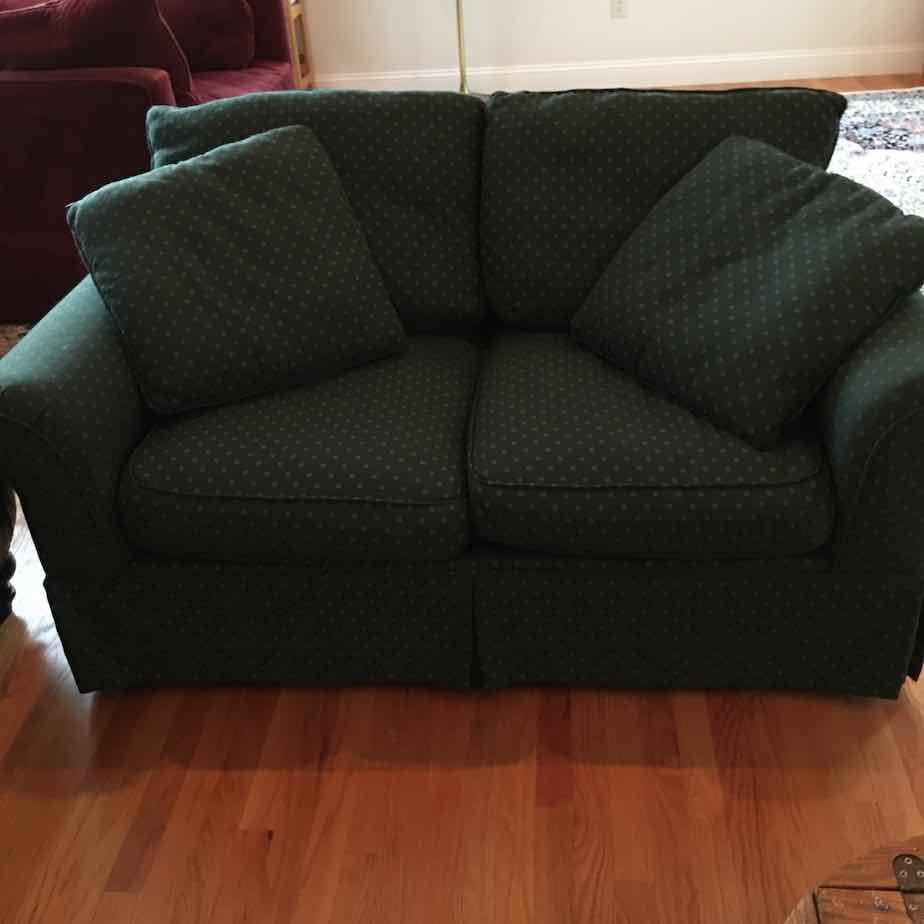How to clean a sofa
How To Clean A Sofa – DIY in Ten Steps
You can clean your own sofa. Here’s how:
Remember way back? Remember when your sofa was new? Has years of use, couch-potatoing, holidays celebrations, and get-togethers taken their toll? If you’re finding that stains, soiling, and even pet hairs are dulling your sofa’s fabric; whilst crumbs, wrappers, and coins litter the crevices, you’re probably asking, “What can be done?”
Fear not! Follow along with us, as a professional upholstery cleaner leads you through the steps of sofa cleaning.
Overview
- Take before photos.
- Brush & vac.
- Check tags for cleaning warnings.
- Spray & wash fabric.
- Rinse.
- Repeat process throughout, including cushions.
- Shine up wood and metal trim.
- Towel dry.
- Allow to fully air dry and take photos, show your friends.
- Celebrate!

Ten Baby Steps To Clean Your Sofa
- Step One: Take plenty of BEFORE photos. If you don’t, you’ll wish you did!
- Step Two: Use a horse-hair brush and a shop vac to gently remove dry soiling. Hint, often times, horse hair brushes are included accessories that come in the box with a new vacuum. Vacuum everywhere! If possible, tilt the sofa back, and vacuum the underside thoroughly, and while the underside is exposed, check for tags, which will contain detailed fabric information. You might also find the tag beneath the cushions. If the couch reclines, fully recline the couch to its extreme extended position. Be sure to gently brush and vacuum all exposed surfaces, and even down deep into the folds. Vacuuming is the most crucial part of the cleaning, so be diligent.
- Step Three: If the tag indicates code “W”, you may proceed to step 4, otherwise, STOP, and read the tag throughly to determine cleaning restrictions. Some materials indicate they are dry clean only , and others will require professional cleaning. Use caution and read tags carefully. If tags are marked with the letters “S”, or “X”, it indicates that the fabrics are not water safe.
- Step Four: Mix up your cleaning solution in a spray bottle, and TEST it in an inconspicuous area of the fabric. Mist on until lightly until the fabric is moistened and let the cleaner dwell. Avoid over-wetting, but don’t overthink it either. After a few minutes of dwell time, spray the treated area with some dry foam, and use your horse hair brush to work the foam into the fabric. The idea is to use the foam to work the cleaning solution into the fabric. Use gentle circular motions, first clock-wise, then counter-clock wise.
- Step Five: Spritz the rinse spray over the cleaned area, and use a white (cotton or microfiber) wash cloth, along with the rinsing solution, to wipe down the cleaned area thoroughly. You’ll notice that all the soiling is being extracted and transferred to the wash cloth, so be sure to have plenty clean white rags on hand. Once the cloth appears to be rinsing clean, move on to the next section.
- Step Six: Use your wet vac with water suction attachment to pull out soiling and moisture.
- Step Seven: Work section by section. Divide the sofa into 8 – 10 sections, and run through all the steps for each section before moving on to the next. Move from section to section until the entire sofa is clean, and don’t forget the cushions.
- Step Eight: Polish the wood, brass and metal. A quick wipe down or polishing of the trim wood and metal makes a terrific final touch. Spend the extra five minutes!
- Step Nine: Wait about fifteen minutes and briskly wipe down entire couch with the remaining dry wash cloths. This will remove any final soiling remaining on your couch. Guess what? You’re done! Your sofa should be fully dry and ready for use in 4 – 6 hours. For faster drying, see tips on speed drying below…
- Step 10: Once dried, Be sure to take AFTER photos and start sending them to friends. Bragging rights have been earned. Go out and celebrate with your besties, and enjoy your victory.
Sofa Cleaning Solution Recipes
Upholstery Cleaning Solution
- 1-1/2 cup warm water.
- 1 teaspoon fabric cleaner.
- 1 teaspoon baking soda.
- 5 drops hydrogen peroxide.
- Combine all ingredients in clean spray bottle.
Upholstery Rinse
- 1 – 1/2 cups cold water.
- 1/2 tablespoon white vinegar.
- 1 tablespoon lemon juice.
- Combine in spray bottle.
Upholstery Rinse Bucket
- 1 gallon water.
- 1 Tbsp white vinegar
What You’ll Need
- Rinse bucket
- Fine fabric soap
- We’ll use wool safe laundry detergent.
- Woolite, Tide free & gentle, Suavitell
- Dollar store spray bottles – 2
- White vinegar
- Lemon juice
- Try squeezing a real lemon!
- 8 – 10 Clean white washcloths.
- Wool Safe Foam (you can use upholstery or carpet)
- Shop vacuum, or a household upright w/ upholstery hose.
How to dry a sofa – fast!
Fastest sofa cleaning tip: avoid over-wetting!
- 1. Turn on you ceiling fans.
- 2. Open windows.
- 3. Turn on Air Conditioning.
- 4. Lay couch cushions out in partial shade.
- Place cushions safely on clean dry surface.
- Don’t place in direct sunlight.
- Beware rain & thunderstorms.
- Flip cushions over after 60 minutes.
- 5. If you have fans, you can direct wind toward sofa.
- 6. Run a dehumidifier in the same room as the sofa.
- 7. Gently hand dry/towel dry with clean cotton towels.
- Gently towel over damp areas in a circular motion.
- Replace towels as needed.
- Check towels for color fast and bleed.
- 8. Special tips for winter drying
- heat, wood stove, pellet stove, fireplace – on.
- A/C on. If you can tolerate it.
- Dehumidifier.
- Windows open, 5 – 10 minutes per hour until dry.
- Elbow grease – lots of towel drying (see step 7 – above)
Video: How to clean a sofa.
How to safely clean stains on your sofa.
- Peroxide:
- pet stains, urine, vomit, blood (& odors from these stains)
- All purpose: Mix 1 tps. Woolite & 1 tsp Vinegar in 3 cups water.
- coffee, tea, ketchup, egg, urine, ink, wine, crayon
- Rubbing alcohol
- ink stains, water-based paint, glue
- Nail polish remover (acetone)
- some inks, varnishes, nail-polish, crazy glue, glue

